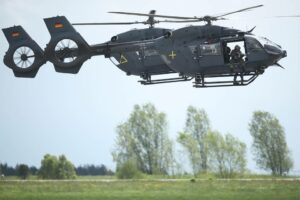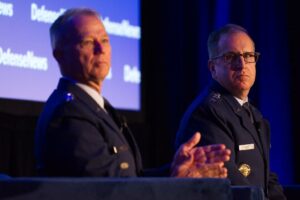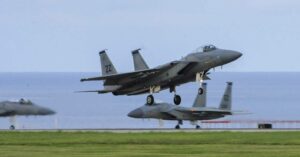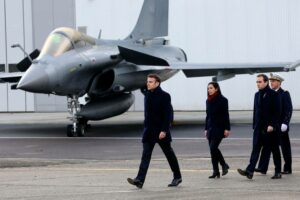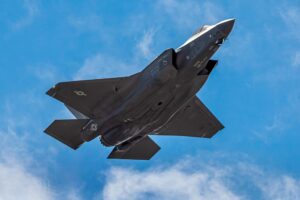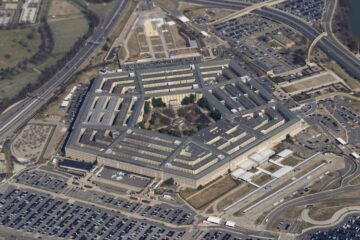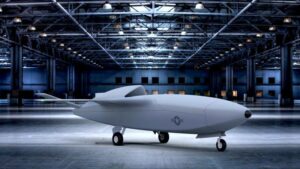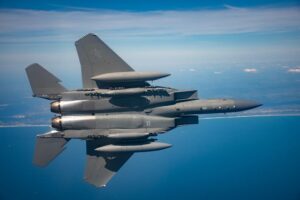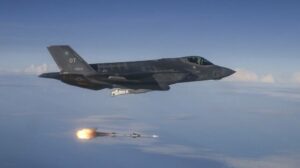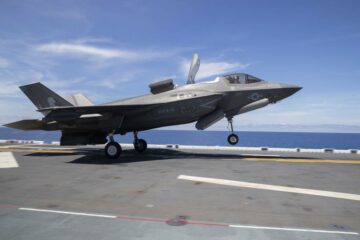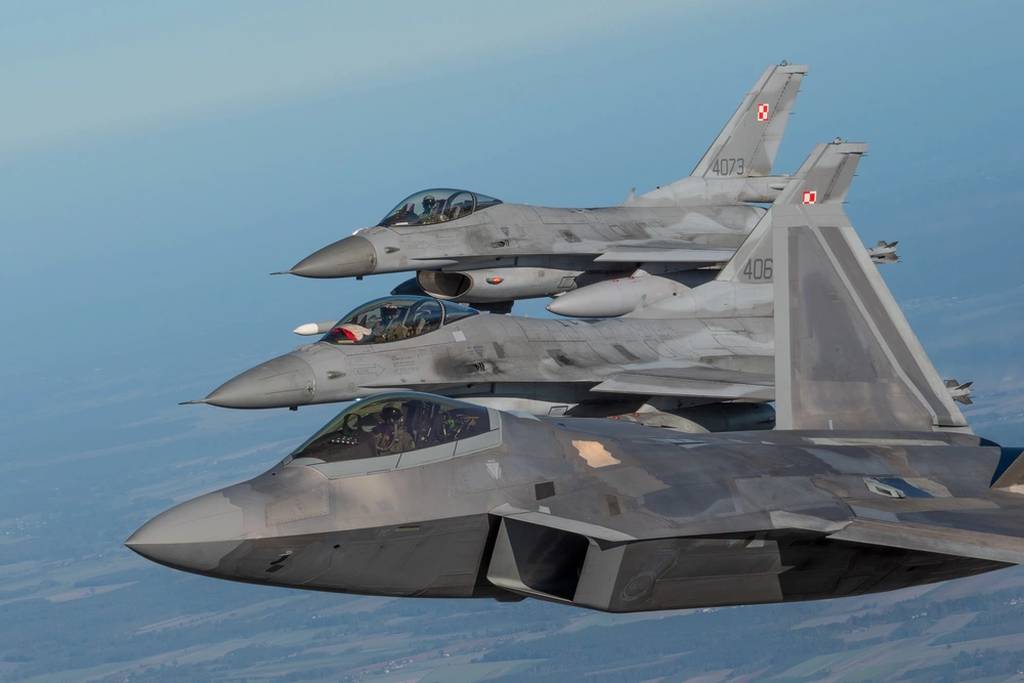
Nineteen months into Russia’s war on Ukraine, its lessons are shaping how the U.S. Air Force thinks about combat over Europe.
The conflict is pushing the Pentagon to focus on tactics instead of the strategic-level chess moves that have defined the U.S.-Russia military relationship in Europe since the end of the Cold War, Gen. James Hecker, the Air Force’s top officer in Europe, told Air Force Times in a recent interview.
No longer are allied air forces passively circling over Europe for the sake of visibility. U.S. pilots and their counterparts now use air policing missions to practice offensive and defensive maneuvers along NATO’s eastern border.
Struck by Russia’s inability to control Ukrainian airspace and Ukraine’s inability to fully secure it, NATO has begun working through the details of how it would maintain ownership of its own skies while breaking through enemy defenses to secure more airspace.
Hecker said his top priority has become figuring out how to counter air and missile defenses, electronic jamming and other anti-access, area-denial (A2/AD) capabilities, as they are known in military parlance, that would keep the U.S. out of Russian territory.
And it’s a main focus of U.S. and allied discussions at NATO’s highest levels.
A revamp of NATO’s regional security plans led by Army Gen. Christopher Cavoli, the head of U.S. European Command and one of the transatlantic alliance’s two strategic commanders, has spurred a new look at how member militaries would fight future wars if deterrence fails.
Those are “geographically specific plans that describe how we will defend key and relevant places in our alliance” against Russia and terror groups, Royal Netherlands Navy Adm. Rob Bauer, chairman of NATO’s military committee, said in May.
To the greatest extent seen since the end of the Cold War, he said, the alliance is setting goals to develop the capabilities it needs to thwart specific threats, like hypersonic weapons and unmanned vehicles.
“Together this family of plans will significantly improve our ability and readiness to deter and defend against any threats, including on short or no notice, and ensure timely reinforcement of all allies,” NATO said in a statement at its July 11 summit in Lithuania. “We have committed to fully resource and regularly exercise these plans to be prepared for high-intensity and multi-domain collective defense.”
A closer look
For the allied air forces, that requires a closer look at how to defend their own airspace and gain access into an enemy’s. Delegates from each member nation began answering that question at NATO’s first weapons and tactics conference, or “WEPTAC,” at Ramstein Air Base, Germany, July 17-28.
Officials discussed the aircraft and weapons that the alliance would need for the counter-A2/AD mission in Europe, and hashed out techniques airmen would use in the field, Hecker said.
U.S. Air Force officials have pointed to unmanned aircraft, stealthy and long-range assets, and electronic weapons as options to distract or destroy defensive systems and clear the way for more traditional combat aircraft.
“We did a lot of the tactical-level planning for that kind of mission,” Hecker said. “We will use that planning to actually do rehearsals and practices as we continue our enhanced air policing on [NATO’s] eastern border.”
U.S. airmen have begun honing those moves in training sorties with European aircraft on the eastern flank, he said. It’s one example of how allied airpower has evolved alongside the conflict across NATO’s border.
After Russia launched its full-scale invasion of Ukraine in February 2022, armed NATO jets flew around-the-clock air patrols to discourage the conflict from spilling into other European nations. That kept Russian forces at bay but arguably left NATO airmen less ready for conflict, Hecker said.
“If you just do circles with missiles on board, you’re not actually practicing what you’re going to do in combat,” he said.
Once leaders were convinced that the alliance’s airspace was safe, airmen changed tack. Now pilots on patrol also take part in anti-access training along NATO’s border — pairing the deterrent value of an air patrol with the tactical value of real-world practice.
NATO will also put those tactics to the test at a major new training exercise, Ramstein Flag, in Greece at the end of 2024, Hecker said.
“We don’t want to go to war with Russia, and I don’t think they want to go to war with us either,” he said. “But we need to make sure that we have the forces capable of deterring them, so that nothing bad will happen.”
NATO will look for other opportunities to try out new tactics in large exercises, particularly those that combine multiple types of aircraft for more realism, Hecker said.
Those events could include Ukrainian pilots at the end of their training to fly the U.S.-built F-16 Fighting Falcon, he added.
POLITICO reported Aug. 4 that eight Ukrainians who are fluent in English are ready to learn to operate the fighter jet once a syllabus is created by a coalition of European countries and approved by the United States. It’s unclear when that might come to fruition.
Ahead of Ramstein Flag, U.S. Air Forces in Europe will continue trying to reform the classification rules that hinder how it shares combat data with others in NATO, from satellite imagery to targeting information collected by the F-35 Lightning II fighter jet.
“There’s things that we could share when it comes to A2/AD that would make us more integrated … and we could do the mission better, if they knew the capabilities that different countries had,” Hecker said. “We’re getting through some of those barriers and we’re able to brief certain folks on some of those capabilities, so we can fight better … as a team.”
Hecker also wants to ensure the alliance could carry out its combat objectives even if its communications are disrupted. And U.S. airmen can learn from Ukraine’s success at keeping its military aircraft from being targeted on the ground, by continually moving and maintaining a light footprint, he said.
The growing catalog of training events are part of a new era on NATO’s path to grow national investments in the alliance’s mutual defense since 2014.
Asked whether the U.S. should commit additional air squadrons to Europe, Hecker instead pointed to another sign of those investments: the rising number of European countries that have signed onto the F-35 Joint Strike Fighter program.
Within the next 10 years, Hecker said, more than 600 F-35s will be spread across the continent — only 54 of which are slated to be American.
“The European NATO allies are really stepping up to the plate and taking it seriously,” Hecker said. “I think you’re going to see, over the next several years, better tactics, better integration, and all that means better deterrence.”
That growing commitment can ensure a strong military presence in Europe without relying too heavily on the Pentagon, whose top priority is sending forces to deter Chinese aggression in the Pacific.
“You’re never going to have as many forces as you want … but I think we’re sitting in a pretty good position right now,” Hecker said of U.S. airmen in Europe. “I think everyone understands where we are with the National Defense Strategy, and it doesn’t get very heated during those discussions.”
Rachel Cohen joined Air Force Times as senior reporter in March 2021. Her work has appeared in Air Force Magazine, Inside Defense, Inside Health Policy, the Frederick News-Post (Md.), the Washington Post, and others.
- SEO Powered Content & PR Distribution. Get Amplified Today.
- PlatoData.Network Vertical Generative Ai. Empower Yourself. Access Here.
- PlatoAiStream. Web3 Intelligence. Knowledge Amplified. Access Here.
- PlatoESG. Automotive / EVs, Carbon, CleanTech, Energy, Environment, Solar, Waste Management. Access Here.
- PlatoHealth. Biotech and Clinical Trials Intelligence. Access Here.
- ChartPrime. Elevate your Trading Game with ChartPrime. Access Here.
- BlockOffsets. Modernizing Environmental Offset Ownership. Access Here.
- Source: https://www.defensenews.com/news/your-air-force/2023/08/18/ukraine-war-prompts-new-us-air-tactics-in-europe/
- :has
- :is
- :not
- :where
- $UP
- 10
- 11
- 13
- 2014
- 2021
- 2022
- 2024
- 70
- a
- ability
- Able
- About
- access
- across
- actually
- added
- Additional
- against
- AIR
- Air Force
- aircraft
- airspace
- All
- Alliance
- along
- alongside
- also
- American
- an
- and
- Another
- any
- appeared
- approved
- ARE
- arguably
- armed
- Army
- AS
- Assets
- At
- Aug
- Bad
- barriers
- base
- Bay
- BE
- become
- began
- begun
- being
- Better
- board
- border
- Breaking
- but
- by
- CAN
- capabilities
- capable
- carry
- catalog
- certain
- chairman
- changed
- Chess
- chinese
- Christopher
- circles
- classification
- clear
- closer
- cohen
- cold
- Collective
- combat
- combine
- come
- comes
- commit
- commitment
- committed
- committee
- Communications
- Conference
- conflict
- continually
- continue
- control
- convinced
- could
- Counter
- countries
- created
- data
- Defense
- defensive
- defined
- delegates
- describe
- destroy
- details
- develop
- DID
- different
- discussed
- discussions
- do
- Doesn’t
- Dont
- during
- each
- eastern
- either
- Electronic
- end
- English
- enhanced
- ensure
- Era
- Europe
- European
- European Countries
- Even
- events
- everyone
- evolved
- example
- Exercise
- extent
- fails
- falcon
- family
- February
- field
- fight
- fighting
- First
- Focus
- Footprint
- For
- Force
- Forces
- Frederick
- from
- fruition
- full-scale
- fully
- future
- Gain
- Gen
- Germany
- get
- getting
- Go
- Goals
- going
- good
- greatest
- Greece
- Ground
- Group’s
- Grow
- Growing
- had
- happen
- hashed
- Have
- he
- head
- Health
- heavily
- her
- highest
- hinder
- his
- How
- How To
- HTTPS
- i
- if
- ii
- images
- improve
- in
- inability
- include
- Including
- information
- inside
- instead
- integrated
- integration
- Interview
- into
- invasion
- Investments
- IT
- ITS
- james
- Jets
- joined
- joint
- jpg
- July
- just
- Keep
- keeping
- kept
- Key
- Kind
- known
- large
- launched
- leaders
- LEARN
- Led
- left
- less
- Lessons
- levels
- light
- lightning
- like
- Lithuania
- longer
- Look
- Lot
- magazine
- Main
- maintain
- maintaining
- major
- make
- many
- March
- May..
- means
- member
- might
- militaries
- Military
- missiles
- Mission
- missions
- months
- more
- moves
- moving
- multiple
- mutual
- nation
- National
- Nations
- Need
- needs
- Netherlands
- never
- New
- next
- no
- nothing
- Notice..
- now
- number
- objectives
- of
- offensive
- Officer
- officials
- on
- once
- ONE
- only
- operate
- opportunities
- Options
- or
- Other
- Others
- our
- out
- over
- own
- ownership
- Pacific
- pairing
- part
- particularly
- path
- pentagon
- Pilots
- Places
- planning
- plans
- plato
- Plato Data Intelligence
- PlatoData
- policing
- policy
- position
- Post
- practice
- practices
- prepared
- presence
- pretty
- priority
- Program
- Pushing
- put
- question
- Readiness
- ready
- real world
- really
- recent
- reform
- regional
- regularly
- relationship
- relevant
- relying
- Reported
- reporter
- requires
- resource
- right
- rising
- rob
- royal
- rules
- Russia
- russian
- s
- safe
- Said
- sake
- satellite
- satellite imagery
- secure
- security
- see
- seen
- sending
- senior
- seriously
- setting
- several
- shaping
- Share
- Shares
- Short
- should
- sign
- signed
- significantly
- since
- Sitting
- skies
- So
- some
- specific
- spread
- Statement
- States
- stealthy
- stepping
- Strategic
- Strategy
- strike
- strong
- success
- Summit
- sure
- Systems
- tactical
- tactics
- Take
- taking
- targeted
- team
- techniques
- territory
- test
- than
- that
- The
- The Washington Post
- their
- Them
- These
- they
- things
- think
- Thinks
- this
- those
- threats
- Through
- times
- to
- too
- top
- traditional
- Training
- Transatlantic
- try
- two
- types
- u.s.
- U.S. Air Force
- Ukraine
- ukraine war
- Ukraines
- Ukrainian
- Ukrainians
- understands
- United
- United States
- us
- use
- value
- Vehicles
- very
- visibility
- want
- wants
- war
- was
- washington
- washington post
- Way..
- we
- Weapons
- were
- What
- when
- whether
- which
- while
- WHO
- whose
- will
- with
- without
- Work
- working
- would
- years
- you
- zephyrnet

